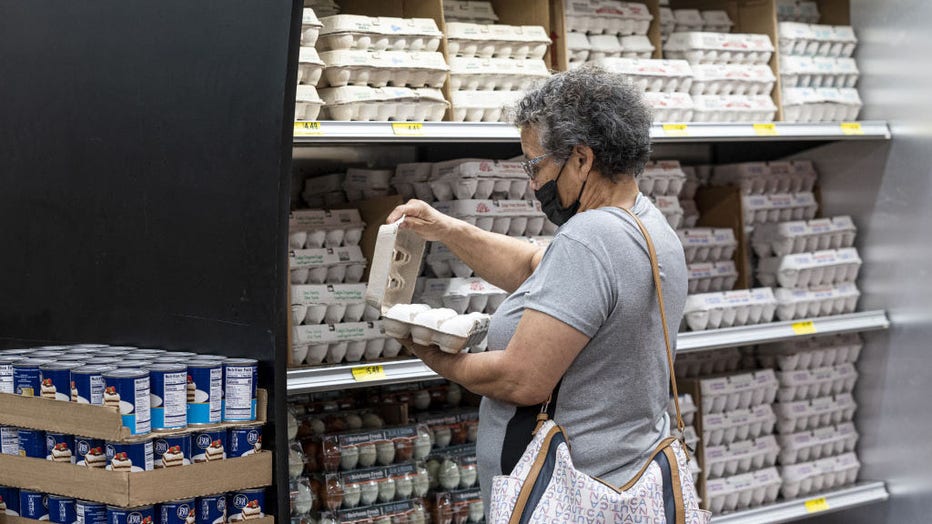Here's how much more you'll be paying for food in 2022, according to USDA estimates
WASHINGTON - Facing the worst inflation levels in decades, U.S. consumers this year have seen record gas prices and can also expect to pay more for food at both the grocery store and while dining at restaurants, according to predictions from the U.S. Department of Agriculture.
The Food Price Outlook 2022, a Consumer Price Index for food that measures inflation and is released by the USDA’s Economic Research Service, states that food prices in March 2022 were 8.8% higher than a year prior.
Overall, it estimates that food prices at grocery stores and supermarkets will increase between 5% and 6% this year, while restaurant prices are expected to jump between 5.5% and 6.5%.
The USDA’s research service noted Russia’s war against Ukraine, as well as the Federal Reserve recently raising its key interest rate by a half-percentage point — its most aggressive move since 2000 — as factors putting continuing "upward and downward pressures on food prices, respectively."
Looking at several food products, including meat, poultry, seafood, oils, produce, sugar and sweets and nonalcoholic beverages, the outlook noted how there were no price declines for any food-price category in March.
In 2021, beef and veal products had the largest relative price increase (9.3%), while fresh vegetables had the smallest (1.1%), the outlook noted. No food categories decreased in price in 2021 compared with 2020.
Here are several foods that are likely to see the notable price increases in 2022 — and by how much, according to the USDA’s Economic Research Service:
Poultry, eggs
Retail prices for poultry products have been high, with "historically low stocks of frozen chicken," the outlook said. It also noted the ongoing bird flu outbreak, which could lead to price jumps due to decreased supply or a reduced drop in international demand for U.S. poultry products.
Egg prices increased by 1.9% in March 2022, following a 2.2% increase in February, the research service said.
Overall, poultry prices are expected to see the highest jump in prices this year, between 7.5% and 8.5%, while egg prices are predicted to increase between 6.0% and 7.0%.

FILE IMAGE - A shopper checks a carton of eggs inside a grocery store in San Francisco, California, on May 2, 2022. Photographer: David Paul Morris/Bloomberg via Getty Images
Meat
In 2022, beef and veal prices are predicted to increase the most, between 6.0% and 7.0%. Pork prices are predicted to increase between 4% and 5%, while other meat prices are predicted to increase between 3.5% and 4.5%.
Overall, all meat categories are predicted to collectively increase anywhere between 4.5% and 6.5% in 2022, according to the USDA’s research service.
Fish and seafood
The price of fresh fish and seafood jumped 0.8% between February and March 2022. This year, the category is expected to climb between 5% and 6% in price.
Dairy
"Rapid increases" in the consumption of dairy products have led to price jumps at grocery stores in recent months, the outlook said.
"This trend continued in March 2022 with a 1.2-percent increase in the prices for dairy products," the report stated.
In 2022, dairy product prices are predicted to increase between 6% and 7% in 2022.
Produce, fats and oils
The USDA’s Economic Research Service said the estimated prices for fats and oils, fresh fruits, fresh vegetables, processed fruits and vegetables have all have been "adjusted upward" for the rest of 2022.
These categories all saw large price jumps between January and March 2022.
Compared with 2021, fats and oils prices are predicted to increase between 8% and 9% percent in 2022, fresh fruit prices between 6% and 7%, fresh vegetable prices between 4% and 5%, and processed fruit and vegetable prices between 5.5% and 6.5%.
Sugar and sweets, nonalcoholic beverages, miscellaneous
In a similar fashion as produce, fats, and oils, the USDA said sugar and sweets, cereal and bakery products, nonalcoholic beverages, and other foods will also go up in price this year.
The price of sugar and sweets is expected to jump between 5.5% and 6.5%, cereal and bakery product prices between 6% and 7%, nonalcoholic beverages between 4.5% and 5.5%, and other food prices between 5.5% and 6.5%.
Tips to save money on food
While rising interest rates, inflation and supply chain challenges may be outside of our control, food spending is one area where shoppers can feel an immediate savings impact.
Erin Lowell, a Bowdoin, Maine-based lead educator at the budgeting app You Need a Budget, recommends spending more time cooking or substituting for cheaper ingredients. Specifically, Lowell suggests assessing how much effort you’re currently putting into minimizing your food spending and taking that effort up to the next level.
For example, instead of getting pizza delivered, consider buying a nice frozen pizza for a quarter of the cost. If you already buy frozen pizza, then consider making your own from scratch for just a few dollars’ worth of ingredients.
Planning meals, and actually prepping them for the week, ahead can also help save on food costs and take away the temptation to order out last minute.
"When people are overspending on food, it’s almost always because they’re eating out too often," Jake Cousineau, a personal finance teacher in Thousand Oaks, California, and the author of "How to Adult: Personal Finance for the Real World," told Nerd Wallet.
Keeping the pantry well-stocked can also end up saving money because you can quickly make last-minute meals instead of ordering takeout.
"I try to keep five to 10 easy, budget-friendly meals in the house at all times," Lowell said, mentioning ingredients for homemade pizza, frozen fish with fries and a pasta dish. "It’s never expensive, and I’m always happy to eat it."
Lastly, some local food banks are open to all members of the community who need support — regardless of one’s personal situation or eligibility for other assistance.
This story was reported from Cincinnati. The Associated Press contributed.

